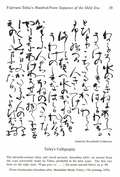Japanese calligraphy
| Part of a series on |
| Calligraphy |
|---|
 |
History
Japanese Calligraphy started with introduction of Kanji from China.[2]
After Buddhism was introduced into Japan, Calligraphy spread rapidly.
Emperors such as Shotokutaishi (聖徳太子) and Shoumu (聖武天皇) wanted people to copy sutras by hand. Also, Japanese envoys to Tang Dynasty China took Chinese culture back to Japan. This affected the way of Japanese Calligraphy.
+{{{1}}}−{{{2}}}
Japanese Calligraphy Media
Japanese calligraphy being written into a Shuin, 2021
Inscription on the halo of the statue of the Medicine Buddha, Hōryū-ji TempleWritten in the 7th century
Cry for noble Saichō (哭最澄上人), which was written by Emperor Saga for Saichō's death. Saga was a scholar of the Chinese classics. He was also renowned as a skillful calligrapher.
A page of calligraphy of a work called the Sarashina nikki (a travel diary by Sugawara no Takasue no musume that Fujiwara no Teika copied in his later years).
A fragment from the "100 Poets anthology"; calligraphy by Hon'ami Kōetsu.
Calligraphy by Musō Soseki (1275–1351, Japanese zen master, poet, and calligrapher. The characters "別無工夫" ("no spiritual meaning") are written in a flowing, connected sōsho style.
References
- ↑ Japan-guide.com, "Japanese calligraphy"; retrieved 2012-6-19.
- ↑ Nussbaum, Louis-Frédéric. (2005). "Calligraphy" in Japan Encyclopedia, pp. 99-101.
Other websites
![]() Media related to Japanese calligraphy at Wikimedia Commons
Media related to Japanese calligraphy at Wikimedia Commons









